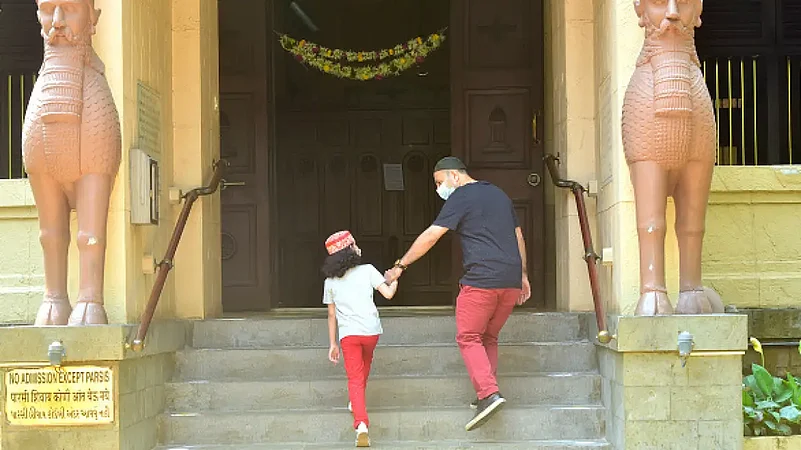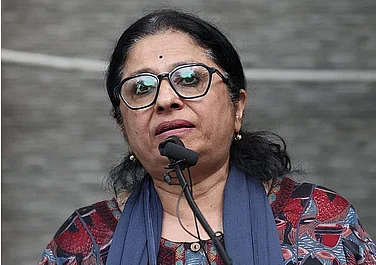Spitama (Zarathushtra)! Never break your promise, whether it is given to an evil person or a righteous co-religionist, because a promise is the same for both (whether given to) an evil or a righteous person. —Meher Yasht, 2
Businessman Ratanji Dadabhoy Tata’s marriage to a French woman, Susaune Briere, in 1903, made news all over the world. The marriage was solemnized by observance of Parsi rites under the Parsi Marriage and Divorce Act of 1865. It was only possible because Susaune converted to a Parsi. Under this act a marriage was between a Parsi man and a Parsi woman. This is why conversion, which was a tenet of the religion, gained so much importance at that time. It gave the Parsis an opportunity to follow their hearts and still remain staunch in their faith. If they had married under the Special Marriage Act of 1872, they would have had to renounce their religion. Today, couples following different religions can marry under the special Marriage Act of 1954 and still keep their individual faith.
This is a love story of two people born almost a generation apart, in two different continents and how the wheels of fortune brought them together.
Ratan D. Tata (nephew of Jamshedji Tata) was in Paris hoping to trade in pearls and silk. He wanted to learn French, so his uncle Jamshedji appointed a teacher named Madame Briere. It was here that he met and fell in love with the teacher’s beautiful daughter Susaune, slim, tall, with beautiful golden hair. She was 20. Ratan informed his uncle Jamshedji about his feelings for the beautiful lady, and his desire to marry her. He was prepared for an angry refusal but, instead, was delighted when Jamshedji readily gave his consent. The wedding was held in 1902 and Jamshedji attended the ceremony in Paris and even delivered a heart-warming speech in the presence of Dadabhoy Navroji.
After the wedding, Jamshedji took Ratan D. Tata and Susaune (now called Sooni after her golden hair) to Britain and hosted a party at Kingston-on-Thames. It was said to be the largest gathering of Parsis hitherto held west of the Suez Canal.
Jamshedji left no stones unturned to make it a grand success. He took his guests on a pleasure ride on the Thames from Westminster to Kingston. A guest present on the cruise writes:
'He played the host to perfection, though he depreciated in courtly manner, the numerous expressions of thanks. His friends Jamshedji and Lady Jeejeebhoy had cut short a tour of Scotland in order to be present. Sir Mancherji Bhownagree represented the House of Commons; Mr Dadabhoy Navroji, doyen of the Parsi residents in England, brought his family.’
Raising a toast to the newlyweds, Sir Mancherji Bhownagree said:
‘I may recall as an example of enlightened sentiments of our host, that recently an event has happened in his family, which I am told, would have been impossible without his sanction and consent. I have the great good fortune to have on my right hand a lady of French nationality who is associated in life and fortune for the rest of her days with Mr Tata. If am rightly informed, Mr Ratanji Tata, the lucky possessor of that bride, had some misgivings as to how the projected union would be regarded by the head of the family. The fact that in spite of his many years of orthodoxy, Mr Jamshedji Tata gave his ready consent to the alliance, is one more proof of his progressive tendencies and his interest in the social advancement of the community.’
Susaune wrote letters to her mother and these letters give an insight into the intense love she shared with Ratan D. Tata. She writes – ‘I only have to look at Ratan (mon petit) and I am truly happy! My husband makes me feel safe, content, protected.’
She reveals to her mother that the religious-minded Ratan was planning to do her navjote and then marry her again by Parsi rites – ‘the official sanction has been given only this morning by the High Priest and Ratan wants the ceremony on Sunday… It will be attended by a whole lot of important Parsis.’ The navjote and wedding were attended by 60 dasturs, when only one was necessary according to scriptural requirements.

‘I will wear an “ijar” and will be wrapped in a white cashmere shawl. But what is most significant is that at the same time the priest will marry us and then no one will give me another thought. I will be allowed to enter the temple or stay in a house where a Parsi lies dead.’
After the navjote and wedding performed by Dastur Kaikhushru Jamaspji, head priest of the Anjuman Atash Behram and Dastur Minocher Jamaspji, she writes to her mother describing the event in detail. (Available with the Tata Central Archives) Here is an excerpt:
Darling mother …. Here I am, at last a Parsi. Everybody is happy for me and so am I. I spent five sleepless nights filling my head with the prayers I had to learn – now I feel exhausted. Let me however try and recount the ceremonies of my conversion and our marriage that took place at Mr Sethna’s big house. At 4 pm, I was made to sit in a small room next to the huge salon in Mr Sethna’s house where the ceremony was going to be performed. A dastur with his face hidden sat opposite me. I recited some prayers with him, ate a piece of pomegranate and then raised my lips in a gesture of sipping a cup of pewter which contained the urine of the cow. It is supposed to purify but of course nobody really drinks it – not even touch it with their lips – but it is a custom that has existed since the beginning. Ratan asked me not to tell you about this (he finds it distasteful). Don’t therefore talk of it. Normally, a dastur is present but this time, he remained on the other side of the partition. The wife of a dastur and the beautiful Meherbai Tata were with me. They dressed me in an ‘ijar’ and confined my hair in a matte bonu and draped a white cashmere shawl around my shoulders. Then feeling very pale and nervous, and with my feet in sapats I entered the drawing room where there were waiting at least 60 dasturs when only one is really necessary. I was made to sit with my back to everyone facing the high priests and I started to recite the prayers with him. After 15 minutes or so, he placed my hands in the sleeves of the sudreh and left, then all the Parsi ladies, the wife of Mr kanga, the daughters of Meherbai and the wife of the dastur held up before me a white sheet to shield me from view. I put on the sudreh, my blouse and a white sari with a silver border. When I was ready, the High Priest returned but this time we stood – he standing just behind me. Then, while I held his little fingers, he tied the kusti around me. Then seated again there were more prayers with the priest showering my head with pieces of pomegranate, rice and coconut. There it ended and I was led into the midst of all our friends who were waiting to congratulate me. Soon only our close friends remained, and the drawing room was prepared for our wedding which had to take place before sunset. I read out aloud, the pledge to the Zoro faitehr, in French, and then the ceremony began. Ratan and I sitting side by side and the dasturs started to pray and showering us with rice. It took about 25 minutes. When everybody except the family and Mr kanga had left, we all drank champagne and then quietly we returned home.”
They were married for 21 years, and had five children – Sylla, Jamshed (J.R.D.), Rodabeh, Darab and Jimmy. As they were married by Parsi religious rites, all the children were accepted as Parsis. During the war, Susaune served as a volunteer and contracted TB in Paris. In 1923, her health was deteriorating. Ratan D. Tata was engaged in the struggle to establish Tata Steel in India. Every day, she would wonder whether he would arrive in Paris in time to see her.
Finally, on the day he got on to the ship to leave for Paris, he received a cable that Sooni was no more. With a heavy heart, he proceeded to France and brought his children back to India where they stayed in the house Ratan was building for his wife. He called the house ‘Sunita’ in her memory.
Excerpted from Who is A Parsi? by Prochy N Mehta (pp. 488, Rs 795), published by Niyogi Books
(Prochy N. Mehta is a daughter, wife, mother, grandmother, school leader and hockey and basketball player. She has represented India in Masters Athletics. Mehta is the first female president of the Calcutta Parsee Club and actively involved in the advertising business.)





















